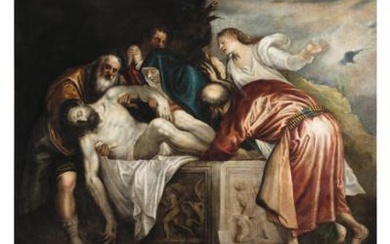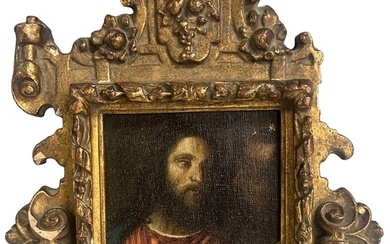Circle of Philip van Dyck, Dutch 1680-1753- The Penitent Magdalene, after Titian; oil on panel, 42.8 x 35.6 cm. Note: Mary Magdalene was an example of the repentant sinner and consequently was frequently adopted as a symbol of the Sacrament of...
Circle of Philip van Dyck, Dutch 1680-1753- The Penitent Magdalene, after Titian; oil on panel, 42.8 x 35.6 cm. Note: Mary Magdalene was an example of the repentant sinner and consequently was frequently adopted as a symbol of the Sacrament of Penance. She was a prostitute, a woman with a dissolute past who, according to the Gospels (Luke 7, 36-50), came to the house of Simon the Pharisee to ask Jesus for forgiveness, weeping penitent tears on the feet of Christ, which she then dried with her hair. Here, she is shown raising her teary eyes to heaven. The subject gained popularity in sixteenth- and seventeenth-century Italy amongst aristocrats, religious figures and the wealthy middle class alike, with Titian and his workshop, for example adopting the subject for many works, at least seven of which are known today. The present work is clearly a later interpretation of these such works. Philip van Dyck became one of the most sought-after painters in The Hague during the second quarter of the 18th Century, earning him the sobriquet 'little van Dyck'. In the present work, the sophisticated handling of the Magdalene, the foreground still life elements, and the landscape background all point to his influence.
Please refer to department for condition report
View it on
Estimate
Reserve
Time, Location
Auction House
Circle of Philip van Dyck, Dutch 1680-1753- The Penitent Magdalene, after Titian; oil on panel, 42.8 x 35.6 cm. Note: Mary Magdalene was an example of the repentant sinner and consequently was frequently adopted as a symbol of the Sacrament of Penance. She was a prostitute, a woman with a dissolute past who, according to the Gospels (Luke 7, 36-50), came to the house of Simon the Pharisee to ask Jesus for forgiveness, weeping penitent tears on the feet of Christ, which she then dried with her hair. Here, she is shown raising her teary eyes to heaven. The subject gained popularity in sixteenth- and seventeenth-century Italy amongst aristocrats, religious figures and the wealthy middle class alike, with Titian and his workshop, for example adopting the subject for many works, at least seven of which are known today. The present work is clearly a later interpretation of these such works. Philip van Dyck became one of the most sought-after painters in The Hague during the second quarter of the 18th Century, earning him the sobriquet 'little van Dyck'. In the present work, the sophisticated handling of the Magdalene, the foreground still life elements, and the landscape background all point to his influence.
Please refer to department for condition report







